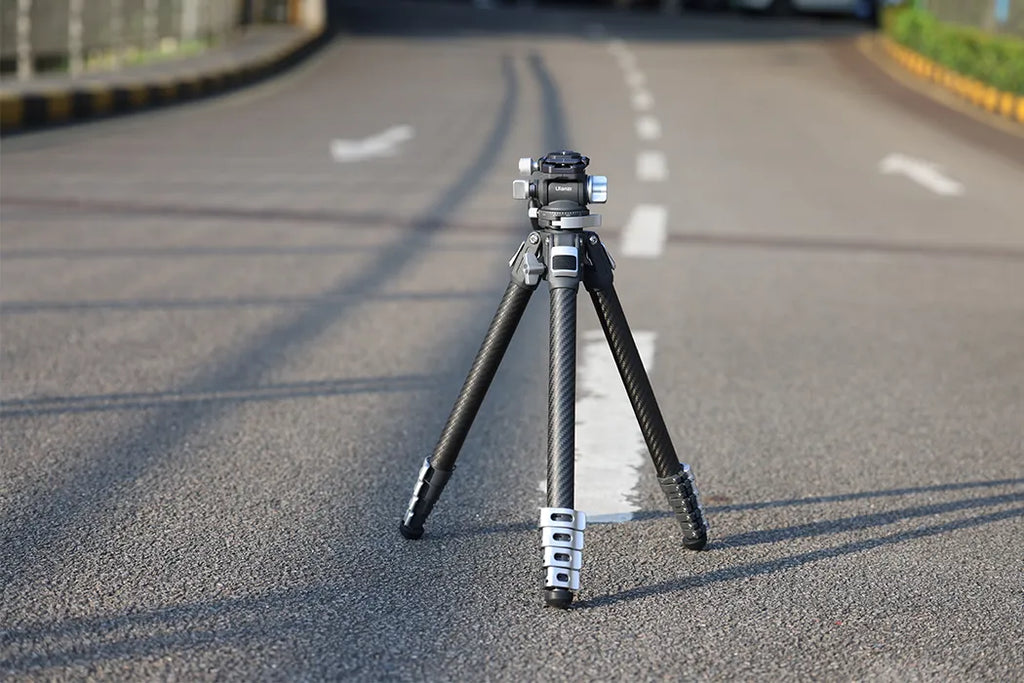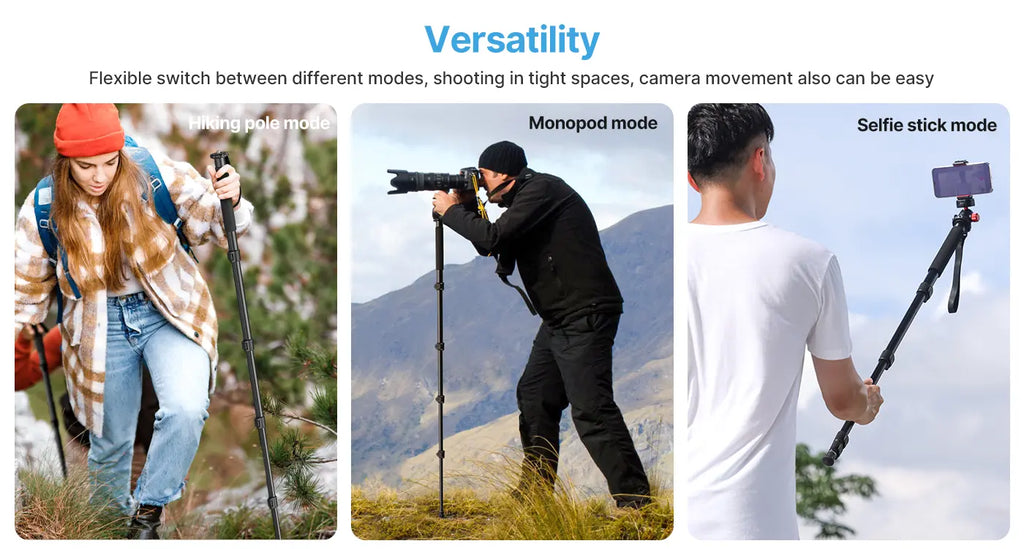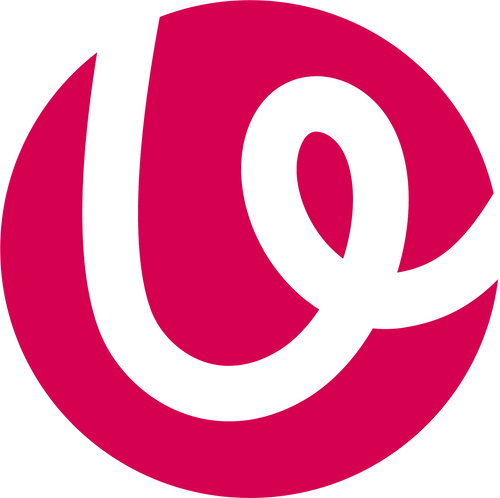When you're out taking photos or shooting videos, how your camera stays still can make all the difference. That's where tools like monopods and tripods come in handy. A monopod is like a one-legged support stick that helps you keep the camera steady without weighing you down. It's quick to set up and easy to carry around, especially when you're in a tight spot. On the flip side, a tripod has three legs and gives your camera a rock-solid stand. It might take a bit more time to get ready, but once it's up, your camera won't shake at all. This article will walk you through what each one does best so you can figure out if a monopod or a tripod is the right choice for getting those great shots.

Quick Comparison Sheet
|
Feature |
Monopod |
Tripod |
|
Design |
Single extendable leg |
Three spread out legs for stability |
|
Portability |
Lightweight, easy to carry |
Heavier and more cumbersome |
|
Setup Speed |
Quick to set up in seconds |
Slower to set up |
|
Stability |
Less stable than tripods, dependent on user for balance |
Provides a stable base for the camera |
|
Mobility |
High mobility, easy to maneuver |
Restricted movement, takes time to reposition |
|
Flexibility |
Pivots and angles easily |
Adjustable height and angles, generally offers more options |
|
Load Capacity |
Suitable for lightweight setups |
Can support heavier cameras and lenses |
|
Application |
Action/Sports, Wildlife, Events, Vlogging |
Long exposures, Studio work, Landscape, Architecture |
|
Long Exposure |
Not suitable |
Necessary for maximum sharpness |
|
Cost |
Generally less expensive |
More expensive with additional features |
|
Maintenance |
Simpler mechanics, potentially fewer issues |
More parts, may need more regular maintenance |
Why Use a Monopod? Breaking Down the Pros and Cons
What is a Monopod?
A monopod is a support stick for your camera that has only one leg. It's designed to help you keep the camera steady while you're taking pictures or videos.

Key Features of Monopods
- Single-leg Design: The basic design of a monopod is one extendable leg. This makes it easy to support your camera on a single point of contact with the ground.
- Portability and Weight: Monopods are lightweight and easy to carry around. They often weigh less than tripods, which makes them a good option for when you want to travel light.
- Speed of Setup:You can set up a monopod in just a few seconds. This means you can get ready to take your shot quickly without missing any action.
- Flexibility and Mobility: With a monopod, you can move your camera more freely. You can pivot and angle the camera without having to pick up and move the whole stand.
Pros of Using a Monopod
- Enhanced Maneuverability: Monopods allow you to move easily through tight or crowded spaces where a tripod would be too large or impractical.
- Ideal for Tight Spaces and Crowded Venues: In places where space is limited, like busy streets or packed events, monopods are great because they don't take up much room.
- Quick Transitions and Adjustments:If you need to change the direction or height of your camera, you can do it quickly with a monopod, which helps you keep up with the action.
Cons of Using a Monopod
- Limited Stability Compared to Tripods: Monopods don't offer as much stability as tripods since they only have one leg instead of three. This means your camera might not be as still, especially for shots that require absolutely no movement.
- Dependence on the User for Balance: Because a monopod only has one leg, you'll have to use your hand to keep it upright and steady, which might be difficult if you're trying to hold it still for a long period.
- Not Suitable for Long Exposure Shots: For photos where the camera needs to stay completely still for a long time, like night-time shots or scenes with moving lights, a monopod might not be the best choice because it can't provide the same level of steadiness as a tripod.
Monopods are useful tools that offer quick setup and flexibility for photographers who need to move around a lot. However, they have some limitations compared to tripods, particularly when it comes to achieving rock-solid stability for certain types of shots. Now that we've covered what monopods can do, we'll look at tripods to see how they can meet different needs.
What Sets Tripods Apart? A Look at Their Features
What is a Tripod?
A tripod is a three-legged stand that supports your camera. It's used to hold the camera steady and is very helpful when you need to take a photo or record a video without any shaking.

Key Features of Tripods
- Three-legged Design: Tripods have three legs, which spread out to create a stable base for your camera. This setup helps prevent tipping and shaking better than a single support point can.
- Stability and Balance: The main goal of a tripod is to provide a stable platform for your camera. This means less blur in your photos and smoother video recordings.
- Variety in Height and Positions: You can adjust the height of tripods and angle them in different ways, giving you lots of options for how to set up your shot.
- Add-on Features like Heads and Levels:Many tripods come with extra features like swivel heads that let you turn the camera smoothly, and levels to make sure your shots are straight.
Pros of Using a Tripod
- Essential for Long Exposures and Time-Lapses: When you need to keep the camera absolutely still for a long time, like when you're taking pictures of stars moving across the sky or shooting a time-lapse video, a tripod is essential.
- Hands-Free Operation: With a tripod, you can set up your shot and then step away from the camera. This is useful if you want to be in the photo or if you're taking multiple shots of the same scene.
- Precise Framing and Stability for Video:For videos, especially interviews or scenes where the camera needs to stay still, tripods are perfect. They help you frame your shot exactly how you want it and keep it steady throughout the recording.
Cons of Using a Tripod
- Cumbersome to Transport and Set Up:Tripods can be heavy and awkward to carry, especially if you're walking a long distance or hiking. Setting them up also takes more time than monopods.
- Can Be Restrictive in Dynamic Environments:In situations where things are moving quickly and you need to change your position often, tripods can feel restrictive because they take longer to move and adjust.
- Generally Heavier and More Expensive:Tripods tend to weigh more than monopods, which can be tiring to carry around. They also usually cost more, due in part to their larger size and additional features.
Tripods offer unbeatable steadiness for a variety of photography and videography needs, making them invaluable for certain types of shots. However, their size and weight might not make them the best choice for every situation. Understanding both the advantages and drawbacks of using a tripod will help you decide when it's the right tool for your next shoot.
Monopod or Tripod: What's Best for Your Camera?
Situations Best Suited for a Monopod
- Sports and Wildlife Photography:In fast-paced environments such as sports events or in nature, a monopod is ideal because it allows you to move quickly and set up your shot without losing time.
- Photojournalism and Event Coverage:When covering news stories or events where you need to take photos from different angles swiftly, a monopod is a great choice due to its ease of movement.
- Vlogging and Mobile Filming:If you're filming yourself or taking video while on the move, a monopod can be less disruptive and easier to handle than a tripod, making it good for vloggers and mobile filmmakers.

Situations Best Suited for a Tripod
- Landscape and Architectural Photography:For shots that require precision and a perfectly still camera, such as landscapes or buildings, tripods are the best option because they provide a stable base.
- Studio Photography and Portraiture: In a studio setting or when taking portraits, tripods allow you to carefully compose your shot and ensure your subject is well-framed and in focus.
- Astrophotography and Macro Photography:Capturing the stars or tiny subjects in great detail requires a very steady hand, or better yet, no hand at all. Tripods eliminate camera shake in these sensitive shooting conditions.
Cost Comparison and Value for Money
In terms of cost, monopods are generally more affordable than tripods. Monopods offer quick mobility and ease of use. For example, Ulanzi's 61-inch Camera Portable Aluminium Monopod, priced around $16.99 to $26.99, exemplifies an affordable option that doesn't sacrifice functionality for active shooters on the move.
Tripods tend to be pricier due to their enhanced stability and feature set. They are crucial for shots requiring precision, such as long exposures. To illustrate, while Ulanzi offers a basic tripod starting at just $9.95, their premium travel tripod, priced up to $299.95, caters to professional needs with its robust build and stability.
Durability and Maintenance Considerations
Both monopods and tripods are built to last, but since tripods have more parts, there's a bit more that can go wrong. Proper care involves regular cleaning, especially if they've been used outdoors. Tripods might also need extra attention to make sure their moving parts stay smooth and functional. Monopods have simpler mechanics, which can mean fewer maintenance issues over time.
When weighing the pros and cons of monopods versus tripods, think about what kinds of photos or videos you're looking to make, how much weight you're willing to carry, and what kind of investment you want to make into your gear. Each has its place in photography, and choosing the right one can make all the difference in getting that perfect shot.
When to Opt for a Monopod and When to Go with a Tripod?
When it comes to choosing between a monopod and a tripod, the decision should be based on your specific needs, preferences, and type of work. Here's a structured approach to help you make a well-informed choice:
Assessing Your Primary Type of Photography/Videography
- Action and Sports Photography: Use a monopod for its quick maneuverability.
- Wildlife Photography: A monopod is beneficial for moving quickly but you can also use a tripod when waiting for long periods.
- Event Coverage/Photojournalism: Monopods are easier to carry in crowded spaces.
- Vlogging/Mobile Filming: Opt for a monopod for its lightweight convenience.
- Landscape Photography: A tripod is necessary for stability over long exposures.
- Architectural Photography: Tripods are essential for precise framing and sharpness.
- Studio Photography/Portraiture: Tripods provide consistent stability for controlled settings.
- Astrophotography/Macro Photography: A tripod is a must-have for precision and eliminating camera shake.
Balancing Convenience with Quality of Output
- Choose a monopod if you prioritize ease of movement and setup speed over absolute stability. This may slightly compromise image sharpness in certain situations but will allow greater flexibility.
- Opt for a tripod if achieving the highest quality images or videos is non-negotiable, even if it means dealing with added weight and setup time.
Considering Future Needs and Potential Upgrades
- If you foresee needing to support heavier cameras or lenses, or anticipate engaging in photography that requires ultimate sharpness, a tripod might be a worthwhile investment, even if it's not an immediate need.
- If your future points toward more travel, hiking, or on-the-go shooting, a lightweight and easy-to-carry monopod could be more suitable.
Personal Preference and Comfort
- Reflect on past experiences: Did you ever feel burdened by carrying too much gear? If so, a monopod might offer the relief you're looking for.
- Consider your physical comfort: If you have back or shoulder issues, a lighter monopod could be preferable, unless you require the stability of a tripod for your shots.
- Think about patience levels and workflow: If you prefer setting up shots quickly, go with a monopod. If you have the patience for meticulous setup and crave precision, a tripod aligns better with your style.
What Else Should You Think About When Picking a Monopod or Tripod?

When deciding between a monopod and a tripod, aside from the situations in which they will be used, there are several other factors to consider that can influence your choice:
- Material Differences: Monopods and tripods are typically made from either aluminum or carbon fiber. Aluminum stands are more cost-effective and durable but tend to be heavier, which could be a factor if you plan to carry them for extended periods. Carbon fiber options are lighter and reduce the strain on your arms and back but usually come at a higher price point. They also absorb vibrations better than aluminum, potentially leading to steadier shots.
- Compatibility with Cameras and Lenses: It's crucial to ensure that the monopod or tripod you choose can support the weight of your camera and lens. Heavier professional gear may require a more robust stand with a higher weight capacity. Check the specifications of the stand to make sure it's compatible with your equipment, paying particular attention to the type of head and mounting plate to ensure a secure fit.
- Environmental Factors: The environment where you'll be shooting can greatly impact the effectiveness of your monopod or tripod. In windy conditions, a tripod's broader base can offer more stability, but it should also have a hook for adding extra weight, such as a camera bag, for even greater steadiness. Uneven terrain demands flexible leg adjustments; tripods generally offer more options for leveling out the camera compared to monopods.
- User-specific Needs: Your physical attributes, like height, can dictate the maximum height you'll need your stand to extend, ensuring you can shoot comfortably without having to stoop. The strength and endurance of the user will also play into the decision-carrying a heavy tripod around all day might not be practical for everyone. Lastly, consider your workflow: do you need to set up and break down quickly? Do your shoots involve a lot of movement and repositioning? Answering these questions can guide you towards the right choice to complement how you work.
Final Thoughts: Selecting the Best Support Between Monopod and Tripod
Choosing between a monopod and a tripod comes down to your shooting style and needs. If you're always on the go and need a quick setup, a lightweight monopod is ideal. But if your focus is on high-quality, stable shots requiring long exposures, like in landscapes or studio work, you'll want the steadiness of a tripod. Budget matters, but investing in what truly suits your workflow pays off in your results. For some photographers and videographers, having both might be the best solution, ensuring preparedness for every situation and the ability to capture images exactly as envisioned.






